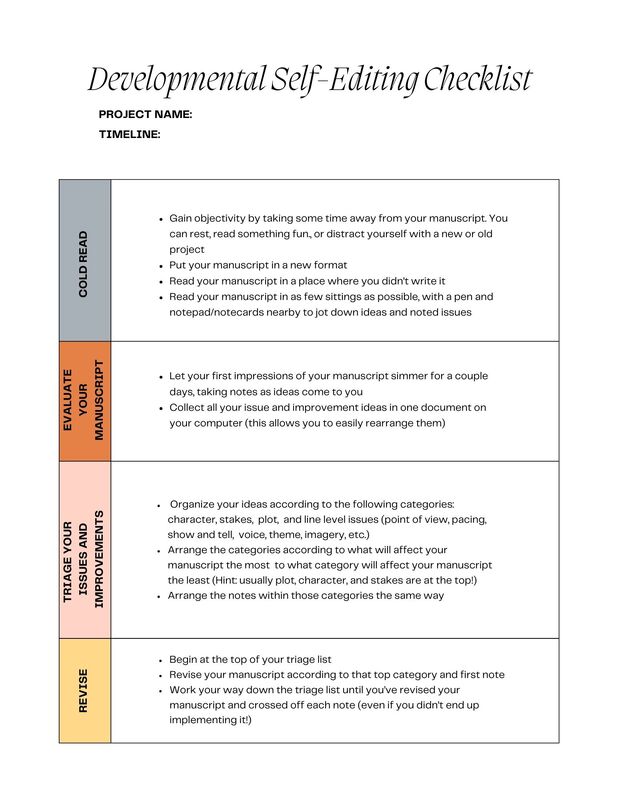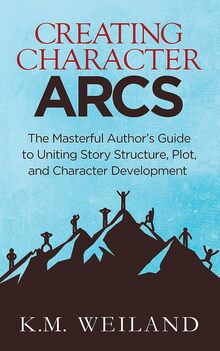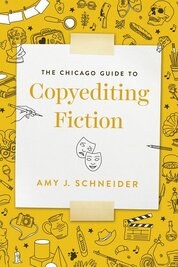What's discussed in this post
Introduction
You just finished your draft. Congratulations!
… Now what? Even for the experienced author, revising a short story or novel can be a daunting task because the advice out there is often this broad or vague. Authors need specific and actionable advice so they feel confident in approaching a revision. That’s where the developmental edit comes in. A developmental edit is an evaluation of a manuscript's bigger picture (or macro) elements, which includes character, stakes, and plot. It may also address some micro edits such as pacing, structure, showing and telling, point of view, and tension. The point is to get the bones of the story in proper shape. While hiring a professional to perform a developmental edit or editorial critique is always a good option, every author should attempt to do it themselves first. Learning to evaluate your own manuscript will not only help you hone your craft, but it will save you money. The structure of a developmental self-edit
So, what is the structure of a developmental self-edit? Here’s the basic outline:
This post goes into how to perform a cold read. By the end, my hope is that you can approach this first step of revising your manuscript with confidence and clarity. What is a cold read and how do you do one?
For a developmental editor, the cold read is the first read-through of the manuscript. Reading through the manuscript prior to digging into a developmental edit allows an editor to get an overall feel of the manuscript’s character, plot, stakes, and themes; the author’s style; and the obvious issues to address. Typically, no actual editing is performed on this first read, but the editor will have a checklist or notepad nearby to jot down notes or ideas.
A cold read is more easily done by a developmental editor because the manuscript isn’t precious to them. They go into the read with the needed objectivity. As the author, you don’t have that advantage. So, the first step of performing a cold read is to gain objectivity, and the second step is the read-through. Step 1: Gain objectivity
What you and your manuscript really need is objectivity. Here are three ways to help you get it:
1. Take time and distance away from your manuscript
Established authors, editors, agents, and book coaches all emphasize the importance of stepping away from your manuscript, giving it (and you) time to rest. I’ve seen many suggest letting the manuscript rest for at least six (6) weeks. This is often easier said than done. Sometimes, we are too excited to put our manuscript aside for long, and other times, we are on deadline, whether self-imposed or not. However, Tiffany Yates Martin says even a few days away from the manuscript can be effective—if you distract yourself. Here are some distraction methods:

General Revision – Intuitive Editing by Tiffany Yates Martin. I cannot recommend this book enough. It’s the first book on revision with clear, practical, and actionable advice. It makes my neurodivergent brain happy.
Show vs. Tell – I haven’t seen a better book on showing and telling than Understanding Show, Don’t Tell (And Really Getting It): Learn how to find—and fix—told prose in your writing by Janice Hardy. Like Intuitive Editing (which has a chapter on this!), Hardy’s book gives actionable advice with great examples. Both books have the format of “how to find it and how to fix it,” which I find extremely helpful!
Short stories have the added benefit of helping you hone your craft while you create something for your newsletter. Pick up Brevity: A Flash Fiction Handbook by David Galef to learn about the different formats of flash fiction and how to revise it.
Tip: Explore a new genre through a short story. It will distract you even further from the book you just finished.
2. Read the manuscript in a different place than you wrote it
As Yates Martin says, “The brain is a creature of habit.” So, if you try to read your manuscript in the same place as you wrote the draft, your brain will go back into writing mode. You want it in reader mode!
3. Read the manuscript in a new format
This is an essential part of the editing process, I believe. Putting your manuscript in a new format—whether it's a printout, a paperback ordered off of Lulu, on your e-reader, or even with just a different font—tricks your brain into thinking it's not yours and therefore allows you to enjoy it as a reader would.
Step 2: Read your manuscript
Next, you’ll want to read your manuscript in as few sittings as possible. Make sure you have a notepad, notecards, etc. nearby to jot down issues you notice or improvement ideas. DO NOT mark up the manuscript itself (which is why putting it on an ebook reader is such a brilliant idea). If you begin marking up the manuscript, your brain will flip into writer and revision mode, and we’re only focusing on identifying issues and improvements right now.
Also, don't forget to write down good things about your manuscript! What did you enjoy? What is working? Highlight your favorite lines! You'll be happy to have a reminder of what is good about your manuscript as you dig into the revisions. Once you're done with your cold read, it's time to let your first impressions simmer. Our unconscious discovers wonderful ideas when we let it. Leave your manuscript for a couple of days, let your unconscious do its magic, and never be without the means to take notes! To sum it up
Every author should learn how to perform a developmental self-edit because it will not only help them hone their craft but also save them money. A cold read is the first step of a developmental self-edit, and to perform an effective cold read, you need to obtain objectivity. Take time away from your manuscript if you can, and if not, read your manuscript in a new format and a new place than you wrote it. Read your manuscript in as few sittings as possible, and then let your unconscious work its magic before you start on the next step: Evaluating your manuscript.
0 Comments
|
AuthorSarah Hawkins is a geek for the written word. She's an author and freelance editor who seeks to promote and uplift the authors around her. Categories
All
Archives
December 2023
|












 RSS Feed
RSS Feed
